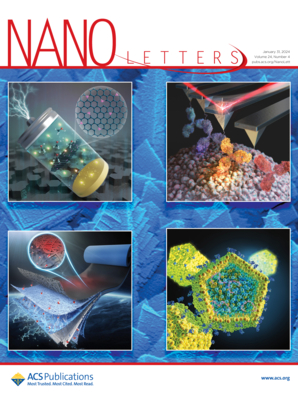原子层沉积生长HfO2/BeO异质介质的高性能氧化薄膜晶体管
IF 9.6
1区 材料科学
Q1 CHEMISTRY, MULTIDISCIPLINARY
引用次数: 0
摘要
原子层沉积生长的氧化铍(BeO)作为一种介电材料,由于其高介电常数、高导热性和宽带隙能量带来的低漏电流,可以最大限度地降低器件功耗,正受到人们的关注。在本研究中,研究了BeO介质对InSnZnO (ITZO)薄膜晶体管(TFTs)的影响,揭示了添加二氧化铪(HfO2)层可以提高电性能和偏置应力可靠性。二次离子质谱和x射线光电子能谱证实,单beo介电基ITZO tft由于Be迁移表现出27.6 cm2/V·s的低迁移率,并且在偏置应力下表现出异常的阈值电压(VTH)偏移。相反,HfO2 20 nm/BeO异质介电ITZO tft具有76.6 cm2/V·s的高迁移率和增强的异常VTH移位特性。因此,这些结果表明,我们的高性能HfO2/BeO异质介电基ITZO tft可以用于单片三维存储技术的后端器件。本文章由计算机程序翻译,如有差异,请以英文原文为准。

High-Performance Oxide Thin-Film Transistors with Atomic Layer Deposition-Grown HfO2/BeO Hetero-Dielectric
Atomic layer deposition-grown beryllium oxide (BeO) is gaining attention as a dielectric material that can minimize device power consumption because of its high dielectric constant, high thermal conductivity, and low leakage current enabled by its wide bandgap energy. In this study, the impact of BeO dielectrics on InSnZnO (ITZO) thin-film transistors (TFTs) was investigated, revealing that adding a hafnium dioxide (HfO2) layer can enhance electrical performance and bias stress reliability. Time-of-flight secondary-ion mass spectrometry and X-ray photoelectron spectroscopy confirmed that the single-BeO dielectric-based ITZO TFTs exhibited a low mobility of 27.6 cm2/V·s due to Be migration and demonstrated abnormal threshold voltage (VTH) shifts under bias stress. Conversely, the HfO2 20 nm/BeO hetero-dielectric ITZO TFTs exhibited a high mobility of 76.6 cm2/V·s and enhanced abnormal VTH shift characteristics. Therefore, these results demonstrate that our high-performance HfO2/BeO hetero-dielectric-based ITZO TFTs could be utilized in back-end-of-line devices for monolithic three-dimensional memory technologies.
求助全文
通过发布文献求助,成功后即可免费获取论文全文。
去求助
来源期刊

Nano Letters
工程技术-材料科学:综合
CiteScore
16.80
自引率
2.80%
发文量
1182
审稿时长
1.4 months
期刊介绍:
Nano Letters serves as a dynamic platform for promptly disseminating original results in fundamental, applied, and emerging research across all facets of nanoscience and nanotechnology. A pivotal criterion for inclusion within Nano Letters is the convergence of at least two different areas or disciplines, ensuring a rich interdisciplinary scope. The journal is dedicated to fostering exploration in diverse areas, including:
- Experimental and theoretical findings on physical, chemical, and biological phenomena at the nanoscale
- Synthesis, characterization, and processing of organic, inorganic, polymer, and hybrid nanomaterials through physical, chemical, and biological methodologies
- Modeling and simulation of synthetic, assembly, and interaction processes
- Realization of integrated nanostructures and nano-engineered devices exhibiting advanced performance
- Applications of nanoscale materials in living and environmental systems
Nano Letters is committed to advancing and showcasing groundbreaking research that intersects various domains, fostering innovation and collaboration in the ever-evolving field of nanoscience and nanotechnology.
 求助内容:
求助内容: 应助结果提醒方式:
应助结果提醒方式:


